Abstract
The oxidative electrochemistry of cymantrene, CpMn(CO)3 (1; Cp = [η5-C5H5]–), was examined in ionic liquids (ILs) composed of anions of varying Lewis base properties. It was observed that the cyclic voltammetric responses strongly depended on the nucleophilic properties of the IL anion. Still, all observations are consistent with the initial formation of 1+ followed by an attack from the IL anion. In bis(trifluoromethylsulfonyl)amide [NTf2]-based ILs, the process shows close to ideal electrochemical reversibility as the reaction between 1+ and [NTf2] anion is very slow. On the other hand, in tetrafluoroborate and trifluoromethanesulfonate-based IL, the oxidation of 1 shows different levels of electrochemical reversibility with a marked sign of anion attack to 1+. In contrast, 1 exhibits an irreversible oxidation process in hexafluorophosphate-based IL. The reaction rate constants for the interaction of 1+ with the different IL anions were estimated by fitting the experimental data to digital simulations of the proposed mechanism. Besides, the use of [NTf2]-based ILs as a supporting electrolyte in CH2Cl2 was also examined. The oxidation process of 1 shows a close to ideal electrochemical reversibility but low to non-chemical reversibility. This study illustrates the wide range of electrochemical environments available with ILs and demonstrates their limited utility for investigating the redox properties of metal carbonyl compounds. It also intends to warn the reader on how the IL media may influence an electrochemical study if care is not exercised.
1. Introduction
The solvent selection is one of the essential features for the success of a planned reaction, as the solvent choice can affect equilibrium and rate-determining reaction times, as well as the product distribution [1,2]. In molecular solvents, the solvent-solute interaction may involve dipole–dipole interactions and other intermolecular forces such as hydrogen bonding, π-interactions, London dispersion forces, or even coordinative bonds. Since ionic liquids, ILs, have properties completely different from molecular solvents (e.g., water and organic solvents), it is likely that they will have dramatic effects on reactions occurring within them [3,4,5,6]. However, the structural origins that control ILs physicochemical properties are still unclear. Considering the number of already available ionic liquids, chemists and electrochemists need, in addition to their intuition, some general rules to facilitate the choice for a specific electrochemical application. Accordingly, there is an obvious need to characterise the nucleophilicity of ILs. While studies on the role of molecular solvents and/or electrolytes in organometallic redox systems have been widely studied for many years [7,8,9], it is perhaps surprising that analogous studies in IL media have not been equally reported.
To probe the effect of IL anions on electrogenerated species, the redox chemistry of the piano-stool complex MnCp(CO)3 (1, Cp = [η5-C5H5]–), often referred to as cymantrene, will be investigated in a range of ILs as the solvent and in dichloromethane (CH2Cl2) having the ILs as supporting electrolyte. This complex was selected because its electron transfer and coupled chemical reaction pathways have been well-characterised in conventional media and vary substantially with the nature of the molecular solvent and nucleophile used [10,11,12,13,14,15,16,17,18,19]. It is known that the electrophilicity of the 17-electron organometallic radical (1+), generated as the oxidation product of 18-electron cymantrene (1, Equation (1)), is susceptible to cleavage reactions with either donor solvents, supporting electrolyte anions, or added nucleophiles (L in Equation (2)) [18], undergoing fast substitutions of one or two carbonyls (CO) ligands. The chemical reaction that follows the electron transfer may be expected as removing an electron from 1 would weaken the Mn-CO bonds (owing to reduced metal-to-CO back-bonding) and perhaps the Mn-Cp bond [11]. In contrast, in weekly coordinating media, such as CH2Cl2 containing tetrabutylammonium tetrakis (pentafluorophenyl)borate as the supporting electrolyte, only the chemically reversible one-electron oxidation process (Equation (1)) was observed [11].

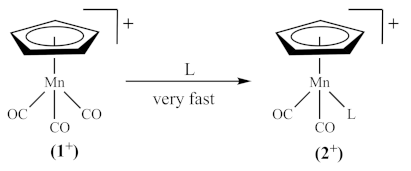
The susceptibility mentioned above of 1+ to nucleophilic attack by the solvent or supporting electrolyte makes the electrochemical oxidation of 1 an excellent system to examine the chemical reactivity of the IL media. This work describes the oxidative electrochemistry of 1 in five different ILs. The anions employed in these studies, hexafluorophosphate, [PF6]–, tetrafluoroborate, [BF4]–, bis-(trifluoromethylsulfonyl)amide, [NTf2]–, and trifluoromethanesulfonate, [CF3SO3]–, cover an important range of Lewis basicity and, as will be described, exhibiting markedly different reactivity toward electron-deficient species. The oxidative electrochemical behaviour can be explained by the initial generation of 1+ and its subsequent reactivity toward the IL anion. Besides, the oxidation of 1 was also examined in CH2Cl2 with IL or tetrabutylammonium hexafluorophosphate, [Bu4N][PF6], added to serve as the supporting electrolyte. The present study, therefore, pretends to demonstrate the substantial range of electrochemical environments available with ILs and exemplifies the importance of the reactivities of the IL anions in electrochemical studies performed in IL media.
2. Results and Discussion
Ionic liquids are classified according to the Lewis acidity or basicity of their component cations and anions, respectively [20]. Based on the basicity, the four anions employed in this work [NTf2]–, [PF6]–, [BF4]–, [OTf]– were initially classified into a “neutral” category as they were considered extremely weak base anions [20], or more generally as “non-coordinating anion” [21,22]. However, it has recently been recognised that grouping these anions into that category may be misleading since they are Lewis bases, and their interaction with Lewis acid centres is well reported [23,24,25]. A summary of the electrochemical data for oxidation of 1 in each of the ILs is presented in Table 1.

Table 1.
Cyclic Voltammetric data obtained for oxidation of 5 mM 1 in ILs.
Trifluoromethanesulfonate ([CF3SO3]–; [OTf]– or triflate) possess a relatively moderate coordinating ability to metal centres similar to perchlorate and allegedly stronger than [PF6] and [BF4] anions, with many triflate-containing complexes been previously isolated and characterised [21,25,26]. This anion, therefore, may provide ILs with coordination properties similar to solvents such as acetonitrile.
Figure 1 shows the cyclic voltammogram of 1 in [emim][OTf] obtained at a scan rate of 0.02 V s−1. Two processes are observed: an irreversible oxidation at 0.869 V vs. Fc0/+ (indicated as peak IIa) and a shoulder or pre-peak at ca. 0.724 V vs. Fc0/+ (peak Ia). When the potential is scanned in the cathodic direction, no new processes are observed. Since the cyclic voltammetry resembles that previously reported in acetonitrile (0.1 M [Bu4N][ClO4]) containing triphenylphosphine as the nucleophile [19]; by analogy, we assign processes IIa to the oxidation of 2 to 2+ and the pre-peak Ia to the rapid CO substitution in 1+ to give the cation 2+ (Equation (2)). It is noteworthy that the potential separation between the two oxidation processes is smaller than that previously reported in acetonitrile [19].
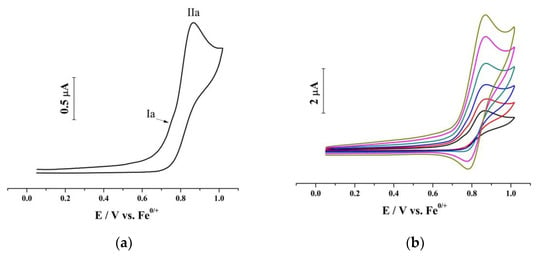
Figure 1.
Cyclic voltammograms obtained for 5 mM 1 in [emim][OTf] at a glassy carbon electrode (d = 1 mm). (a) over a wide potential range with a scan rate of 0.02 V s−1 and (b) over the potential region where the oxidation occurs at scan rates of 0.02, 0.05, 0.10, 0.20, 0.40, and 0.60 V s−1. T = 21 ± 1 °C.
An additional feature accompanies the oxidation of 1 in [emim][OTf]. Process IIa is unstable to further attack by the coordinating solvent, appearing as an irreversible process when the voltammograms are recorded at slow scan rates (≤0.1 V s−1). This observation supports the reaction scheme outlined below (Scheme 1), which involves a catalytic substitution of carbonyl by [OTf]–. The initially formed 1+ is rapidly attacked by [OTf]– to create 2+, which, in turn, reacts with 1 following a disproportionation-type reaction to produce 2 and 1+. The ligand-substitution mechanism is completed by back electron transfer at the electrode potential . The voltammetric results confirmed that the redox potential of 20/+ (named as in Scheme 1) is more positive than the redox potential of 10/+ (). Besides, a followed-up reaction between 2+ and [OTf]– may account for the irreversibility observed at low scan rates.
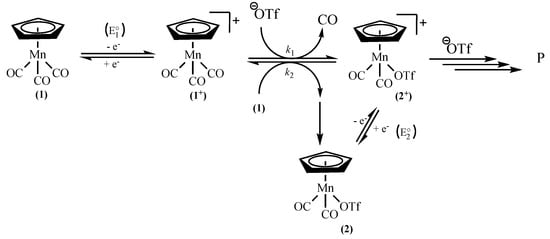
Scheme 1.
Catalytic pathways for the oxidation of 1 in [emim][OTf].
Hexafluorophosphate has been widely employed as a supporting electrolyte anion in electrochemical work because of its very low Lewis basicity. However, it may not be entirely innocent since there is evidence that it can coordinate with or act as a nucleophile toward highly electron-deficient species [18,27,28]. This aspect of its reactivity may be expected to be enhanced in IL media since the [PF6]– concentration in neat IL is roughly a factor of 50 greater than when it is employed as a supporting electrolyte in organic solvents, typically at a concentration of 0.10 M. Indeed, the results indicate that [PF6]-based ILs have considerable reactivity toward electron-deficient species. Figure 2a,b show the cyclic voltammetric response of the oxidation of 1 in [bmim][PF6] obtained at scan rates between 0.02 and 0.60 V s−1. The voltammograms show the fully irreversible oxidation of 1 at 0.891 V vs. Fc0/+, which is maintained even when scan rates of 10 Vs−1 are used. This effect may be attributed to the attack by [PF6]– on 1+ in a reaction analogous to that proposed for triflate in Scheme 1. However, the reaction rate of the followed-up reaction between 2+ and [PF6]– is larger than that observed in [emim][OTf], which accounts for the irreversibility observed at all the scan rates used.
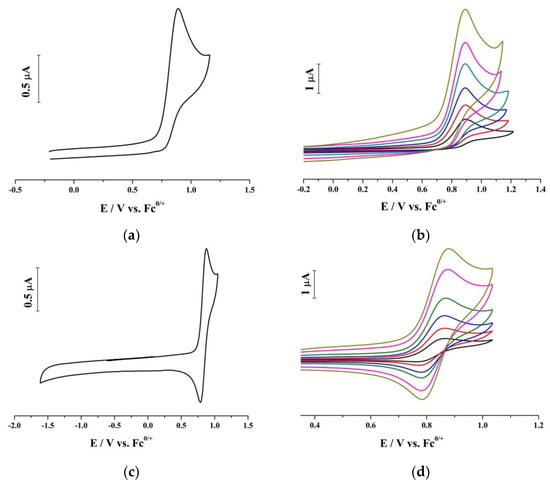
Figure 2.
Cyclic voltammograms obtained for 5 mM 1 in (a,b) [bmim][PF6], (c,d) [bmim][BF4] at a glassy carbon electrode (d = 1 mm). (a–c) over a wide potential range with a scan rate of 0.1 V s−1 and (b–d) over the potential region where the oxidation occurs at scan rates of 0.02, 0.05, 0.10, 0.20, 0.40, and 0.60 V s−1. T = 21 ± 1 °C.
Tetrafluoroborate has also been widely employed as a supporting electrolyte anion in electrochemical work because of its low Lewis basicity. However, numerous crystal structures show [BF4]– as a monodentate or bidentate bridging ligand [21,23]. Furthermore, it has also been realised that this anion may act as a nucleophilic fluoride source [29,30]. Based on this, it is possible to arrive at the early conclusion that [BF4]– could be more reactive than [PF6]–. Nevertheless, despite the cyclic voltammetric response of the oxidation of 1 in [bmim][BF4], obtained at scan rates between 0.02 and 0.60 V s−1, shows measurable reactivity toward 1+ (Figure 2d), they reflect a more reversible behaviour than that seen in [bmim][PF6] (Figure 2) and [emim][OTf] (Figure 1). Figure 2c,d, show the cyclic voltammetric response of the oxidation of 1 in [bmim][BF4] obtained at scan rates between 0.02 and 0.60 V s−1. These voltammograms (see also Table 1) reveal a decrease in peak current ratios at lower scan rates, which may be attributed to a relatively slow attack by [BF4]– or fluoride on 1+ in a reaction analogous to that proposed for triflate in Scheme 1. However, no clear indication of two oxidation waves is observed, which may imply that .
The oxidation of 1 shows even more significant electrochemical reversibility when performed in [NTf2]-based ILs (Figure 3). This comment is supported by (i) the linear behaviour of the oxidative peak current of 1 in [bmpyr][NTf2] and [emim][NTf2] vs. the square root of scan rate over the range 0.1 to 1.00 V s−1, and with concentrations over the range 2.5–10 mM; and (ii) the ∆Ep 70 mV, commonly observed for electrochemically reversible processes in ILs [31,32]. Nevertheless, despite the high electrochemical reversibility of the 10/+ couple in these ILs (Table 1) and the absence of new cathodic voltammetric peaks appearing after the oxidation of 1, there is still evidence of a slow homogeneous reaction coupled to the electron transfer. The ratio obtained in these two ILs attain unity at scan rates ≥1 V s−1, deviating from unity as the scan rates decrease. Such an interaction is consistent with the previously reported interaction of [NTf2]-based ILs with [CpFe(CO)2]2+ [3].
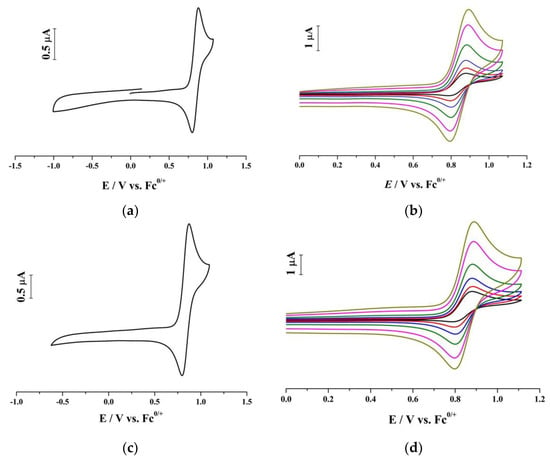
Figure 3.
Cyclic voltammograms obtained for 5 mM 1 in (a,b) [bmpyr][NTf2], (c,d) [emim][NTf2] at a glassy carbon electrode (d = 1 mm). (a–c) over a wide potential range with a scan rate of 0.1 V s−1 and (b–d) over the potential region where the oxidation occurs at scan rates of 0.02, 0.05, 0.10, 0.20, 0.40, and 0.60 V s−1. T = 21 ± 1 °C.
While [NTf2] anion can act as a nucleophile toward highly electron-deficient metal carbonyl species (e.g., CpFe(CO)2(NTf2)) [9], the kinetics of this reaction is very slow in ILs. Therefore, rate constants for the IL anion’s attack on 1 were calculated by fitting experimental voltammetric responses to digital simulations of the process shown in Scheme 1 to measure the relative reactivity of the anions used in this investigation (Figure 4). The value of k2 was first arbitrarily chosen, and the value of k1 changed. When the k1 listed in Table 1 is used, the simulations exhibit excellent agreement with experimental results. It is worth mentioning that the mechanism is not critically dependent on the value of k2 if it is chosen over the range 4 < k2 > 30 for all the scan rates used in this work. Significantly, the oxidation of 1 in [NTf2]-based ILs (Figure 4a,b) shows the smaller k1 values, which is consistent with observation performed with the use of [(Cp)Fe(CO)2]2 as the probe molecule [3]. Nevertheless, the reactivity toward 1+ appears to be a usefully and more sensitive method of discriminating the relative nucleophilicity of IL anions when compared with [(Cp)Fe(CO)2]2. Moreover, simulations of the more complex chemistry in the [PF6]-based IL also gave excellent agreement with the experimental voltammograms over a wide range of scan rates when k1 = 1.8 × 104 s−1 and k2 = 1 × 10−3 s−1, is used to simulate the irreversible conversion of 2+ to a product.
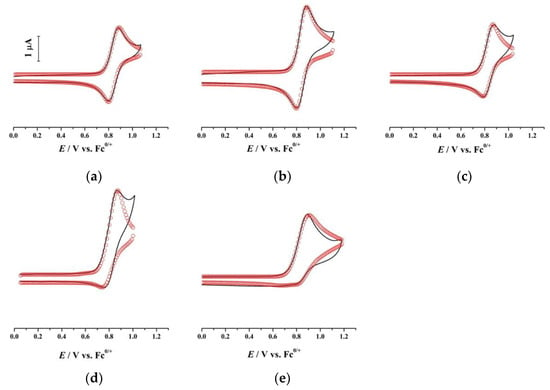
Figure 4.
Comparison of experimental (solid lines) and simulated (open circles) cyclic voltammograms for the oxidation of 5 mM 1 in (a) [bmpyr][NTf2], (b) [emim][NTf2], (c) [bmim][BF4], (d) [emim][OTf], and (e) [bmim][PF6]. The mechanism depicted in Scheme 1 and data from Table 1 were used for simulations. Scan rate = 0.20 Vs−1. T = 294 K, electrode area = 0.7 mm2, charge-transfer coefficient = 0.5, heterogeneous standard rate constant = 1.0 × 10−2 cm s−1, double-layer capacitance = 0.60 μF.
Water is always present as an impurity in ILs and can compete with the IL anions for electrophilic radical cations. To support the contention that the chemical reactions coupled to 1+ observed in ILs is primarily due to the IL anion and not to adventitious water, the cyclic voltammetry of 1 in [bmim][BF4] was examined after the deliberate introduction of additional water. Under these conditions, a new irreversible reduction process coupled with the oxidation of 1 appears at ∼0.21 V vs. Fc0/+ (Figure 5). Based on Scheme 1, the formation of [CpMn(CO)2(H2O)] is expected as a result of the reaction between water and 1+. Accordingly, this new peak is assigned to its one-electron reduction process.
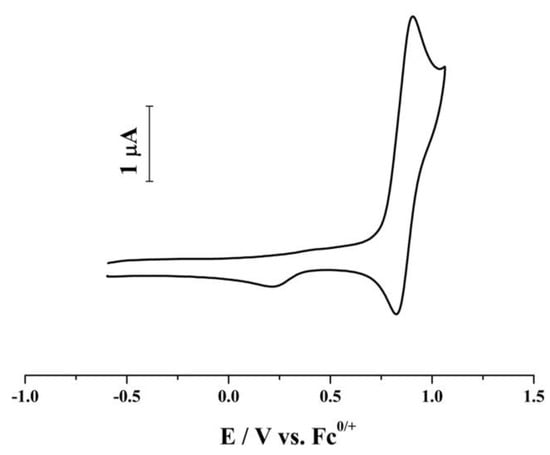
Figure 5.
Cyclic voltammograms obtained for 5 mM 1 in [bmim][BF4] containing 200 ± 10 ppm water at a glassy carbon electrode (d = 1 mm). Scan rate = 0.10 V s−1, T = 21 ± 1 °C.
Due to the [NTf2]– low nucleophilicity, [emim][NTf2] and [bmpyr][NTf2] may be considered useful as weakly coordinating electrolytes in molecular solvents. To this end, the behaviour of [bmpyr][NTf2] as a supporting electrolyte in CH2Cl2 was tested. Oxidation of 1.0 mM 1 in CH2Cl2, containing 1 M [bmpyr][NTf2] as the supporting electrolyte, showed close to ideal electrochemical reversibility (Figure 6), with Em = 0.864 V versus Fc0/+, peak current ratios increasing from 0.87 to 0.96 when the scan rate was increased from 0.1 to 1.0 V s−1, and ∆Ep = 66 mV at 0.1 Vs−1. Interestingly, the diffusion coefficient, extracted from the voltammetric analysis of 1 in CH2Cl2 containing 1 M [bmpyr][NTf2] as the supporting electrolyte, was 2.1 × 10−6 cm2 s−1, which is larger than 0.9 × 10−6 cm2 s−1, obtained for the oxidation of 1 in CH2Cl2 (1 M [Bu4N][PF6]). This may imply a lower viscosity of the solvent media when 1 M [bmpyr][NTf2] is used as the supporting electrolyte. Nevertheless, bulk electrolysis results show a lack of chemical reversibility. Oxidation of 1.4 mM 1 at 1 V vs. Fc0/+ in CH2Cl2 (0.5 M [bmpyr][NTf2]) makes the solution turn to a bluish-red colour during the first 4 min of electrolysis, which colour is characteristic of stable 1+. Nevertheless, the colour disappears during the electrolysis. The total coulombs gave napp = 4.0 electrons per molecule of 1, indicating that ligand substitution takes place in this solvent system.
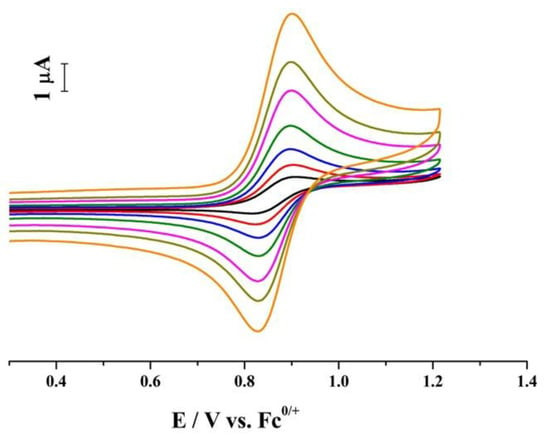
Figure 6.
Cyclic voltammograms obtained for 1 mM 1 in CH2Cl2 containing 1 M [bmpyr][NTf2] as supporting electrolyte at a glassy carbon electrode (d = 1 mm) over the potential region where the oxidation occurs at scan rates of 0.02, 0.05, 0.10, 0.20, 0.40, 0.60, and 1.0 V s−1. T = 21 ± 1 °C.
3. Materials and Methods
Reagents. High purity grade (>99.9%) 1-methyl-3-butylimidazolium hexafluorophosphate, [bmim][PF6], 1-methyl-3-butylimidazolium tetrafluoroborate, [bmim][BF4], 1-methyl-3-ethylimidazolium bis(trifluoromethylsulfonyl)amide, [emim][NTf2], 1-methyl-1-butylpyrrolidinium bis(trifluoromethylsulfonyl)amide, [bmpyr][NTf2], 1-methyl-3-ethylimidazolium trifluoromethanesulfonate, [emim][OTf], were purchased from Merck. Reagent-grade dichloromethane (CH2Cl2, Merck, Darmstadt, Germany), was distilled from appropriate drying agents and stored over CaH2 prior to use. Ferrocene (Fc, 98%, Sigma-Aldrich, Castle Hill, Australia), Silver trifluoromethanesulfonate (AgOTf, 97%, Sigma-Aldrich, Castle Hill, Australia) Tetrabutylammonium hexafluorophosphate ([Bu4N][PF6], ≥99%, Sigma-Aldrich, Castle Hill, Australia), and cyclopentadienylmanganese (I) tricarbonyl (1, 98%, Strem, Newburyport, MA, USA), were used as received from the manufacturer.
Apparatus and procedures. Experimental procedures were performed in a nitrogen-filled glovebox. Glassware used for electrochemical experiments was rinsed with nanopure water, dried at 120 °C for at least 12 h, and cooled under vacuum immediately before use. Unless otherwise stated, the water concentration in IL media was 80 ± 10 ppm, as determined with a Model 756 Karl Fischer Coulometer (Metrohm, Mitcham, Australia) using hydranal Coulomat AG as the titrant.
Voltammetric experiments were performed with an Interface1000 electrochemical workstation (Gamry, Warminster, PA, USA). Uncompensated resistance was measured in a potential region where no Faradaic reaction occurs, using the RC time constant method available with the instrument. This resistance was 85% compensated by the same instrument. The commercially available software package DigiElch (Gamry, Warminster, PA, USA) was used to simulate the voltammetric responses. The voltammograms were obtained using a conventional three-electrode arrangement, consisting of a 1.0 mm diameter glassy carbon (GC, effective area = 0.7 mm2) disk (ALS, Tokyo, Japan), a platinum wire as a counter electrode and an ‘Ag/AgOTf, R’ reference electrode (where R represents the IL under study). This reference electrode was prepared by immersing a silver wire (ALS, Tokyo, Japan) in the ionic liquid of interest containing 10 mM AgOTf and separated by a porous glass frit from the test solution. However, to minimise uncertainties related to potential variation caused by the use of reference electrodes containing different ILs and changes in liquid junction potentials between the test solution and the reference electrode and to ease the comparison between different ILs [4,33,34], each reference electrode was calibrated against Fc (Table 2), and the peak potential or Em data [Em = 1/2( + )] of 1 obtained in each IL system reported vs. Fc0/+ redox system. It should be noted that the Em of ferrocene is affected by the nature of the IL used, and care should be practised to compare the redox potentials [4,34,35]. Prior to each experiment, the working electrode was polished with 0.3 mm alumina (Buehler, Lake Bluff, IL, USA) on a clean polishing cloth (Buehler), sequentially rinsed with distilled water and acetone, and then dried with lint-free tissue paper.

Table 2.
Mid-point potential of Fc0/+ against different Ag/AgOTf, R reference electrode.
4. Conclusions
The present investigation reveals the wide range of electrochemical environments available with ILs and how the media influence the electrochemical reversibility for the oxidation of 1.
The reactivity of the four anions employed in this work follows the order [NTf2]– < [BF4]– < [OTf]– < [PF6]–, indicating that the initial classification of these anions into a “neutral” category is incorrect, as all of them showed a different level of reactivity, and then different Lewis base properties, towards electron-deficient 1+. For example, when [NTf2]– is used, the oxidation of 1 showed good electrochemical reversibility, even at low scan rates or when the IL was used as the supporting electrolyte in CH2Cl2, whereas when [bmim][PF6] was used, the oxidation process was irreversible. On the other hand, in tetrafluoroborate, and trifluoromethanesulfonate-based IL, the oxidation of 1 shows different levels of electrochemical reversibility with a marked sign of anion attack to 1+. These results suggest that 1+ is more sensitive than the previously used [(Cp)Fe(CO)2]2 [3], towards small differences in Lewis basic properties of the IL anions.
With many ILs commercially available and several others readily synthesised in a research laboratory, it should be possible, by the informed choice of the specific anions used, to tune the properties of IL-based electrochemical media for a host of applications, including those requiring exceptionally non-coordinating conditions.
Funding
This research received no external funding.
Acknowledgments
The author would like to thank Muhammad Shiddiky, currently at Griffith University, Australia, for his support during part of the data collection.
Conflicts of Interest
The authors declare no conflict of interest.
References
- Barriere, F.; Geiger, W.E. Use of Weakly Coordinating Anions to Develop an Integrated Approach to the Tuning of Delta E1/2 Values by Medium Effects. J. Am. Chem. Soc. 2006, 128, 3980–3989. [Google Scholar] [CrossRef] [PubMed]
- Barriere, F.; Camire, N.; Geiger, W.E.; Mueller-Westerhoff, U.T.; Sanders, R. Use of Medium Effects to Tune the Delta E1/2 Values of Bimetallic and Oligometallic Compounds. J. Am. Chem. Soc. 2002, 124, 7262–7263. [Google Scholar] [CrossRef] [PubMed]
- Torriero, A.A.J.; Shiddiky, M.J.A.; Bullock, J.P.; Boas, J.F.; MacFarlane, D.R.; Bond, A.M. Electrooxidation of [(η5-C5H5)Fe(CO)2]2 As a Probe of the Nucleophilic Properties of Ionic Liquid Anions. Inorg. Chem. 2010, 49, 2502–2511. [Google Scholar] [CrossRef] [PubMed]
- Torriero, A.A.J.; Sunarso, J.; Forsyth, M.; Pozo-Gonzalo, C. Assessment of permethylated transition-metal sandwich complexes as internal reference redox systems in ionic liquids. Phys. Chem. Chem. Phys. 2013, 15, 2547–2553. [Google Scholar] [CrossRef]
- Crowhurst, L.; Lancaster, N.L.; Perez Arlandis, J.M.; Welton, T. Manipulating Solute Nucleophilicity with Room Temperature Ionic Liquids. J. Am. Chem. Soc. 2004, 126, 11549–11555. [Google Scholar] [CrossRef]
- Yamagata, M.; Tachikawa, N.; Katayama, Y.; Miura, T. Electrochemical behavior of several iron complexes in hydrophobic room-temperature ionic liquids. Electrochim. Acta 2007, 52, 3317–3322. [Google Scholar] [CrossRef]
- Magna, L.; Chauvin, Y.; Niccolai, G.P.; Basset, J.-M. The Importance of Imidazolium Substituents in the Use of Imidazolium-Based Room-Temperature Ionic Liquids as Solvents for Palladium-Catalyzed Telomerization of Butadiene with Methanol. Organometallics 2003, 22, 4418–4425. [Google Scholar] [CrossRef]
- Earle, M.J.; Hakala, U.; McAuley, B.J.; Nieuwenhuyzen, M.; Ramani, A.; Seddon, K.R. Metal bis[(trifluoromethyl)sulfonyl]amide complexes: Highly efficient Friedel-Crafts acylation catalysts. Chem. Commun. 2004, 12, 1368–1369. [Google Scholar] [CrossRef]
- Williams, D.B.; Stoll, M.E.; Scott, B.L.; Costa, D.A.; Oldham, W.J., Jr. Coordination chemistry of the bis(trifluoromethylsulfonyl)imide anion: Molecular interactions in room temperature ionic liquids. Chem. Commun. 2005, 11, 1438–1440. [Google Scholar]
- Huang, Y.; Carpenter, G.B.; Sweigart, D.A.; Chung, Y.K.; Lee, B.Y. Ligand Substitution at 17-Electron Centers. Electroactivation of Functionalized Cyclopentadienylmanganese Tricarbonyl Complexes to Single- and Double-CO Substitution. Organometallics 1995, 14, 1423–1428. [Google Scholar] [CrossRef]
- Laws, D.R.; Chong, D.S.; Nash, K.; Rheingold, A.L.; Geiger, W.E. Cymantrene radical cation family: Spectral and structural characterization of the half-sandwich analogues of ferrocenium ion. J. Am. Chem. Soc. 2008, 130, 9859–9870. [Google Scholar] [CrossRef] [PubMed]
- Chong, D.; Laws, D.R.; Nafady, A.; Costa, P.J.; Rheingold, A.L.; Calhorda, M.J.; Geiger, W.E. [Re(η5-C5H5)(CO)3]+ Family of 17-Electron Compounds: Monomer/Dimer Equilibria and Other Reactions. J. Am. Chem. Soc. 2008, 130, 2692–2703. [Google Scholar] [CrossRef] [PubMed]
- Zoski, C.G.; Sweigart, D.A.; Stone, N.J.; Rieger, P.H.; Mocellin, E.; Mann, T.F.; Mann, D.R.; Gosser, D.K.; Doeff, M.M.; Bond, A.M. An electrochemical study of the substitution and decomposition reactions of (arene)tricarbonylchromium radical cations. J. Am. Chem. Soc. 1988, 110, 2109–2116. [Google Scholar] [CrossRef]
- Volland, M.A.O.; Kudis, S.; Helmchen, G.; Hyla-Kryspin, I.; Rominger, F.; Gleiter, R. Structure and Bonding Properties of the Complex (h5-Diphenylfulvene)Mn(CO)3+. Organometallics 2001, 20, 227–230. [Google Scholar] [CrossRef]
- Ginzburg, A.G. The chemistry of cymantrene. Russ. Chem. Rev. 1993, 62, 1025–1045. [Google Scholar] [CrossRef]
- Lee, S.; Cooper, N.J. Reductive Activation of the h5-Methylcyclopentadienyl Ligand in [Mn(h5-C5H4Me)(CO)3] and Evidence for a Ring-Slipped Intermediate Containing an h5-Methylcyclopentadienyl Ligand. J. Am. Chem. Soc. 1991, 113, 717–719. [Google Scholar] [CrossRef]
- Sweigart, D.A.; Reingold, J.A. Manganese: Organometallic Chemistry. In Encyclopedia of Inorganic Chemistry; King, R.B., Crabtree, R.H., Lukehart, C.M., Atwood, D.A., Scott, R.A., Eds.; Wiley: New York, NY, USA, 2005; pp. 1–16. [Google Scholar]
- Camire, N.; Nafady, A.; Geiger, W.E. Characterization and Reactions of Previously Elusive 17-Electron Cations: Electrochemical Oxidations of (C6H6)Cr(CO)3 and (C5H5)Co(CO)2 in the Presence of [B(C6F5)4]–. J. Am. Chem. Soc. 2002, 124, 7260–7261. [Google Scholar] [CrossRef]
- Hershberger, J.W.; Klingler, R.J.; Kochi, J.K. Kinetics, thermodynamics, and mechanism of the radical-chain process for ligand substitution of metal carbonyls. J. Am. Chem. Soc. 1983, 105, 61–73. [Google Scholar] [CrossRef]
- MacFarlane, D.R.; Pringle, J.M.; Johansson, K.M.; Forsyth, S.A.; Forsyth, M. Lewis base ionic liquids. Chem. Commun. 2006, 1905–1917. [Google Scholar] [CrossRef]
- Beck, W.; Suenkel, K. Metal complexes of weakly coordinating anions. Precursors of strong cationic organometallic Lewis acids. Chem. Rev. 1988, 88, 1405–1421. [Google Scholar] [CrossRef]
- Krossing, I.; Raabe, I. Noncoordinating Anions—Fact or Fiction? A Survey of Likely Candidates. Angew. Chem. Int. Ed. 2004, 43, 2066–2090. [Google Scholar] [CrossRef] [PubMed]
- Grabowski, S.J. Hydrogen Bonds with BF4− Anion as a Proton Acceptor. Crystals 2020, 10, 460. [Google Scholar] [CrossRef]
- Kim, C.W.; Ahn, J.; Kim, S.M.; Noh, T.H.; Jung, O.-S. Polyatomic anion versus acetonitrile in coordinating ability: Structural properties of AgX-bearing 1,4-bis(2-isonicotinoyloxyethyl)piperazine (X− = NO3−, CF3SO3−, ClO4−, BF4−, and PF6−). Transit. Met. Chem. 2011, 36, 545–551. [Google Scholar] [CrossRef][Green Version]
- Hayashida, T.; Kondo, H.; Terasawa, J.-i.; Kirchner, K.; Sunada, Y.; Nagashima, H. Trifluoromethanesulfonate (triflate) as a moderately coordinating anion: Studies from chemistry of the cationic coordinatively unsaturated mono- and diruthenium amidinates. J. Organomet. Chem. 2007, 692, 382–394. [Google Scholar] [CrossRef]
- Strauss, S.H. The search for larger and more weakly coordinating anions. Chem. Rev. 1993, 93, 927–942. [Google Scholar] [CrossRef]
- Hill, M.G.; Lamanna, W.M.; Mann, K.R. Tetrabutylammonium tetrakis[3,5-bis(trifluoromethyl)phenyl]borate as a noncoordinating electrolyte: Reversible 1e- oxidations of ruthenocene, osmocene, and Rh2(TM4)42+ (TM4 = 2,5-diisocyano-2,5-dimethylhexane). Inorg. Chem. 1991, 30, 4687–4690. [Google Scholar] [CrossRef]
- LeSuer, R.J.; Geiger, W.E. Improved electrochemistry in low-polarity media using tetrakis(pentafluorophenyl)borate salts as supporting electrolytes. Angew. Chem. Int. Ed. 2000, 39, 248–250. [Google Scholar] [CrossRef]
- Cresswell, A.J.; Davies, S.G.; Roberts, P.M.; Thomson, J.E. Beyond the Balz–Schiemann Reaction: The Utility of Tetrafluoroborates and Boron Trifluoride as Nucleophilic Fluoride Sources. Chem. Rev. 2015, 115, 566–611. [Google Scholar] [CrossRef]
- Farooq, O.; Tiers, G.V.D. Alkali metal salts of perfluorinated complex anions. Effective reagents for nucleophilic fluorination. J. Org. Chem. 1994, 59, 2122–2124. [Google Scholar] [CrossRef]
- Torriero, A.A.J. Characterization of decamethylferrocene and ferrocene in ionic liquids: Argon and vacuum effect on their electrochemical properties. Electrochim. Acta 2014, 137, 235–244. [Google Scholar] [CrossRef]
- Torriero, A.A.J.; Siriwardana, A.I.; Bond, A.M.; Burgar, I.M.; Dunlop, N.F.; Deacon, G.B.; MacFarlane, D.R. Physical and Electrochemical Properties of Thioether-Functionalized Ionic Liquids. J. Phys. Chem. B 2009, 113, 11222–11231. [Google Scholar] [CrossRef] [PubMed]
- Torriero, A.A.J.; Sunarso, J.; Howlett, P.C. Critical Evaluation of Reference Systems for Voltammetric Measurements in Ionic Liquids. Electrochim. Acta 2012, 82, 60–68. [Google Scholar] [CrossRef]
- Torriero, A.A.J.; Howlett, P.C. Ionic liquid effects on the redox potential of ferrocene. Electrochem. Commun. 2012, 16, 84–87. [Google Scholar] [CrossRef]
- Torriero, A.A.J. Electrochemistry in Ionic Liquids. Volume 1: Fundamentals; Springer: Cham, Switzerland, 2015. [Google Scholar]
Publisher’s Note: MDPI stays neutral with regard to jurisdictional claims in published maps and institutional affiliations. |
© 2022 by the author. Licensee MDPI, Basel, Switzerland. This article is an open access article distributed under the terms and conditions of the Creative Commons Attribution (CC BY) license (https://creativecommons.org/licenses/by/4.0/).